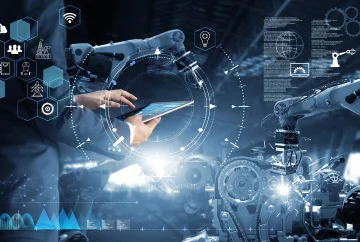In the past few years, AI in the industry has grown to become a cornerstone for sectors such as healthcare, finance, and manufacturing. In addition, it has been attributed as the reason behind the colossal growth of companies like Google, Facebook, Alibaba, and Amazon, among others.
While various other well-established companies and startups alike have followed suit in AI adoption, they cannot deploy it efficiently. These companies lack standardized and consistent parts and quality assurance protocols. As a result, their internal teams are forced to put efforts toward building everything from the ground up even when another team within the organization already has a precedent.
This article discusses the challenges that arise from inefficient AI deployment and how the AI factory model fixes this problem.
The Present State of AI Deployment
The way most businesses implement AI within their organization is inherently flawed. Be it asset tracking or fleet management, businesses are solving problems in silos, and this creates some of the most glaring redundancies and challenges:
- First, teams must solve each problem from scratch, individually.
- The shift from exploration to the production phase is extremely slow given the complexity on the Operations side.
- Each team has a different approach to solving a problem, making it difficult to replicate.
- Finally, the workflows for solving a problem are largely unusable by another team.
- For any functionality that a team develops or a breakthrough, a siloed working strategy makes industrializing AI difficult to scale.
The AI Factory Model
Given the challenges in the existing state of AI adoption across industries, there’s an ongoing revolution to deliver AI platforms that offer built-in governance, security, lineage, bias detection, and explainable AI. These are necessary components for making more trusted AI. To that end, AI Factory is a well-organized model that works on existing fundamental principles to deploy AI across departments successfully. It combines key factors such as platform, data, people, and process to deliver on the pre-defined goals and nurture learning and growth.
Not much different from a physical factory that creates physical products at scale productively and reliably, an AI Factory model can deliver AI solutions to businesses at scale. It brings the best of data, people, products, and processes together to tread beyond experiments and deliver practical AI solutions that bring value.
Building on the premise of creating a robust information architecture for sustainable AI success, AI Factory combines everything from CloudOps and DataOps to MLOps and PeopleOps.
CloudOps
Cloud Operations (CloudOps) is the common practice of managing the delivery and optimization of IT services in a cloud environment. This serves as the foundation for the rapid development and deployment of all AI-enabling technologies that help businesses in remote monitoring and enabling factory automation systems.
DataOps
DataOps is a set of collaborative data management practices that improve communication and integrate automated data flows between managers and consumers in an AI Factory.
SecOps
Security Operations (SecOps) is a collaborative endeavor between the Operations and IT Security teams for protecting corporate assets. This program can help organizations predict outages in an AI Factory and actively identify security vulnerabilities.
AIOps
Artificial Intelligence Operations (AIOps) bring together the best of big data and machine learning to bring AI to factory automation. It helps automate various IT operations, including anomaly detection, event correlation, and casualty determination in an AI Factory environment.
MLOps
Machine Learning Operations (MLOps) is a set of practices for efficiently deploying AI-based models in production, and in an AI Factory, it's the methodology of choice for managing internal processes.
PeopleOps
PeopleOps is the management of labour within an organization that in an AI Factory refers to a common pool of AI-ready skills. With it as a core part of the AI factory model, tasks such as workforce management that were largely repetitive can be automated.
The AI factory model leverages multi-cloud build and deployment strategies and container-based architectures, and no-code dashboards to reduce time to production. Furthermore, persona-based collaborative platforms include various popular tools that can speed up the co-creation process. Data virtualization, again, helps in reducing integration requirements.
DataOps, ModelOps, and MLOps complement the existing DevOps cycles by bringing in the AI perspective of automation. With enough experimentation, its applications can range all the way from support provisioning and risk management to pollution monitoring and manufacturing maintenance.
How does an AI factory work?
In an AI Factory, the quality data obtained from various internal and external sources are used to train machine learning algorithms. These algorithms are used to make fields as varied as drug discovery, shipment monitoring, and inventory management, and they help experts make more informed decisions in more manual tasks. In addition, there are other scenarios where these algorithms can automate tasks with little to no supervision or intervention.
This data-driven model of the AI Factory enables organizations to experiment with new hypotheses and further improve their systems. The implemented changes, in turn, allow the companies to obtain new data, further improve AI algorithms and find new ways to increase performance delivery.

While this continuous improvement paradigm isn't new, AI factories scale it up by introducing natural language processing and computer vision that lacked penetration in the AI manufacturing industry until a few years ago.
As we're all well aware, machine learning algorithms rely heavily on huge amounts of data. But data alone doesn't account for good AI. Many companies today sit on vast data stores, but since they're siloed and stored inconsistently and in an incompatible fashion, they can't be put to immediate use. Moreover, even though an organization is viewed as a unified entity from the outside, the way teams’ function internally is typically quite fragmented. In the case of AI implementation, this has prevented data aggregation and put a blocker to insight generation.
Furthermore, data must be preprocessed before being fed into the algorithm. This step must be followed even if the data is considered largely structured, as there might be gaps in the records that need to be resolved. Again, organizations need to implement a data pipeline between their internal teams and external sources to consolidate data, clean it, process it, integrate it, and store it for future use.
Furthermore, it's highly recommended to create feature teams that will respond to project continuity, transversality, and time to market challenges. It will be composed of a product owner, data engineers and scientists, and DevOps experts. This will ensure evergreen maintenance of the AI solution at hand.
What are the benefits of an AI factory model?
Today, businesses have a wide range of options to choose from regarding personas, tools, techniques, and methodologies. As a result, it can be not easy to pinpoint the starting point for a singular, all-powerful platform that can operationalize AI efficiently and at scale with such variety.
By adopting the AI Factory approach, businesses can bring clarity to their methodologies by focusing on the differentiating factors such as platform, people, product, process, and data. This can help create a prioritized AI roadmap based on pre-defined risk and success criteria, just like a physical factory. With that in hindsight, here are some of the major benefits of an AI factory:
- It empowers you to develop and deploy AI on a common platform for all internal teams.
- It reduces time to production by standardizing operations across teams.
- It offers a common data architecture that is both compliant and secure.
- It helps teams become more productive with increased collaboration.
- It enables organizations to expand quickly to other units and use cases.
Adopting and implementing AI at scale is a massive product management challenge as the very idea of an AI factory demands centralized governance.
When it comes to AI, there're infinite possibilities given it's implemented and deployed correctly. The AI Factory model establishes the core framework for successful implementation and confirms that the tools, processes, and teams are all transferable and replicable within a company, thus ensuring that an organization remains agile while pursuing AI. Furthermore, as soon as the process is established and verified by MLOps, there's nothing stopping the organization from becoming the AI hub in its industry.
Recommended
Digital Transformation | 5 Min Read
Digital Analytics | 6 Min Read



